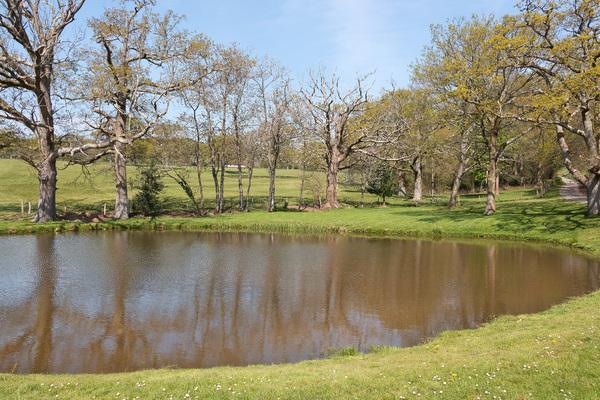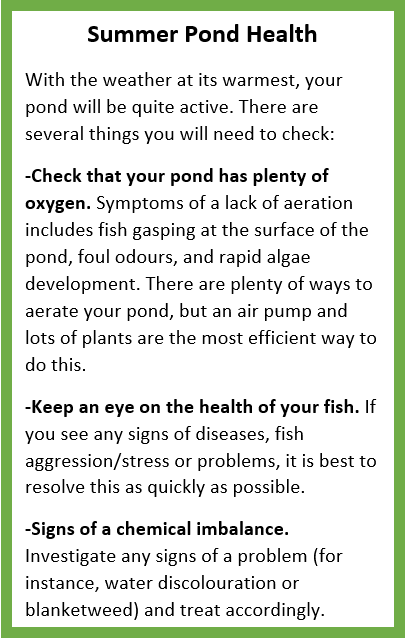Seasonal Pond Maintenance Guide
Trying to find out what sort of maintenance you need to fulfil on your pond throughout the year can be tricky; so we have tried to condense all of our helpful advice into one short blog post. To help condense this information, we have provided links to various other blog posts we have available that may provide more detailed advice should you need this.
In short, a lot of the routine maintenance will remain the same throughout the year. This will include feeding your fish an appropriate amount of food depending on the temperature, checking for pond problems (algae, blanketweed, duckweed etc), pruning plants and general maintenance on your pump and filter.

As the weather warms up and your pond starts to come back to life after the coldness of winter, it is important to prepare the pond, its inhabitants, and any equipment for the warmer months. We have a more detailed blog post on spring maintenance on our Spring Pond Care blog.
Fish
To support your fish, you should bring the pond back into balance; particularly by increasing the number of bacteria into the pond using either the PondXpert Gel Balls or the Blagdon Pond Bio-Start. These will release biological cultures into your pond which maintains the chemical balance of your pond. Additionally, pond salt (either the PondXpert Pond Salt or Blagdon Pond Salt) can be used to lower fish stress, improve fish health, boost filtration, and improve disease resistance for the fish as they come out of their hibernation.
As the temperature of the pond gets above 10 degrees C, you can start to feed your fish. While difficult to calculate, you should feed your fish no more than they can eat in 5 minutes. Any excess food should be removed. You can find out more information on our Fish Food blog. You should also look out for any fish diseases or ailments (white spot, flicking, aggression, etc) and treat these problems accordingly. Please use our Fish Diseases blog post to help diagnose these issues.
Plants
In spring, cut back the growth of your plants, to allow new growths to appear. Fertilise your plants in these early days to replenish the soil, using either the PondXpert Pondbloom Fertiliser or the Laguna Fertiliser Sticks.
Dividing oxygenator plants doesn’t require much work; just choose some healthy new shoots from the off-cuts and plant these in a pond basket. The best time for this is in March and April. For lilies, it is best to divide the lilies every 3-4 years and is normally done in Spring-Summer.
Maintenance
If you are bringing your equipment out of the shed post-winter, it is best to check the condition of your filter. First, check the condition of the UV bulb; can you see a blue glow in your filter? As this will indicate that the UV is working. If not, it is time to replace the UV bulb. You should also replace your foams on an annual basis. You can find out more information on this on our Filters & Their Maintenance blog post.
Throughout the spring period, continue to remove dead leaves or other organic matter from the pond.

Summer is when your pond should be at its best with lush plant growth, active fish, and lots of wildlife making it a wonderful area in the garden for you to enjoy. While this is an overview, there are other maintenance issues you may need to review, as outlined in our Summer Pond Care blog.
Fish
Summer is the best time to add new fish but be careful not to overstock your pond as your filtration may not be sufficient for this. A rough approximation is 3kg of Goldfish per 1000 litres of water, or 1kg Koi per 1000 litres of water.
Plants
In the summer months, your plants will require very little work as they should be receiving all their nutrients from the water, along with the increased sunshine. You may want to add fertiliser to your plants to improve the quality of their bloom and remove any dead or decaying vegetation.
You may also want to increase the plant coverage within the pond; this will increase the surface cover on your pond which will help to prevent Blanketweed and algae blooms.
Maintenance
Regularly maintain your filters and pumps on a weekly or fortnightly bases. Make sure that your UV bulb is functioning and that any mechanical filtration is operating as intended. As before, please refer to our Filters & Their Maintenance blog.
Autumn
Autumn is an ideal time to prepare your pond for the winter period. As the temperatures begin to drop, there are several important steps that you should fulfil for this time of the year. Our Autumn Pond Care includes extra information on this.
Fish
As the temperature decreases, you should begin to feed your fish less, even using a feeding ring to ascertain how much food you should be feeding your fish. As the temperature drops below 10-12 degrees, you should switch your food to a low-protein food like Wheatgerm (a floating thermometer can help you monitor the temperature of the pond).
Once the temperature drops below 6-8 degrees, then stop feeding your fish completely.
Plants
Make sure to put a cover net onto the pond, as this will prevent a variety of debris from entering the pond, which can in turn have an impact upon the water quality. You should also try to remove any dead plants or decaying plant matter and continue to prune any plants that have a dying stem. We have a blog post on Autumn Plant Care that provides extra information.
Maintenance
As the temperature of the pond decreases below 8-10 degrees, your filter can be removed from the pond and stored away (though give it a good clean first!). As explained on our Temperature blog post, the warm water will sink to the bottom of the pond; to prevent mixing the cold surface water, raise your pump.
.png)
Further to the above, we would encourage you to use a pond vacuum to remove as much sludge from the bottom of the pond and to test the water with either the Tetra Pond Test 6-in-1 or the Blagdon Pond Health Test Kit.
Winter
Winter is the time where your pond is at its quietest, but it is important to attend to the pond regularly to keep your fish healthy. You can find out more information on our Winter Pond Care blog.
Fish
In short, continue to refrain from feeding your fish. Some pond keepers may remove their pump, although we recommend that you keep the pump running to prevent your pond from icing over. Alternatively, you can use an air pump or a pond heater. We have more tips on this on our ‘What To Do If Your Pond Freezes Over’ blog.
Plants
With plants dying back in the cold weather, this is the best chance you will have to tidy your pond. Continue to remove the decaying organic material and move any frost-sensitive plants into a safe location; hardy water lilies can be placed in the deeper parts of the pond.
Maintenance
If you haven’t already, you will need to put a cover net over the pond and remove your filter. As above, leave the pump running but turn off any fountains or waterfalls to prevent disturbing your fish.
If you need any further assistance, please email us on info@pondkeeper.co.uk.